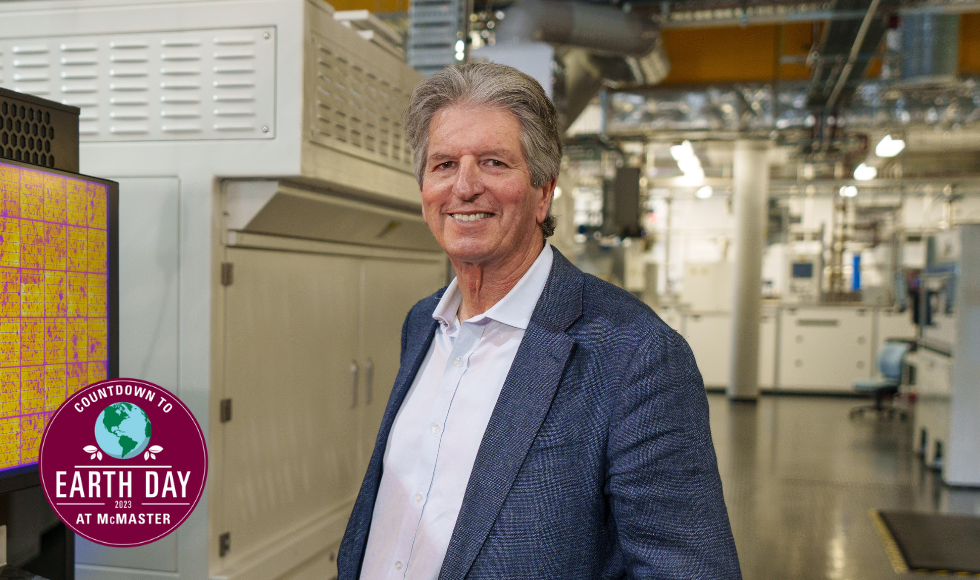Revolutionizing the world’s energy future: From Australia to McMaster and back with Martin Green ‘74

Engineer and solar energy expert Martin Green '74 is delivering the 35th annual J.W. Hodgins Memorial Lecture on April 17, 2023.
Martin Green ’74 may be McMaster’s most prolific world record holder. Typically, thoughts of world records turn to how fast a human can run or how many people can squeeze into a phone booth, but Green is a record holder of a different kind.
An Australian who earned his PhD in engineering physics from McMaster, Green has led the research teams responsible for developing the solar cells that have held world records for efficiency for 30 of the last 40 years, beginning with Green’s first standard-setting cell in 1983.
His best-known record-holder is the Passivated Emitter and Rear Cell (PERC) which became the world’s most-manufactured solar cell in 2018 and now accounts for about 90 per cent of total worldwide production.
“There are now more PERC solar cells out there generating electricity than all other solar generation [technologies] in the history of the human race,” says Green.
PERC has been so successful because it has improved power-generating efficiency while simultaneously lowering production costs. That potent combination has pushed the technology to the top of the solar power marketplace and, in Green’s words, “has made it one of our major weapons in combatting climate change.”
Green’s McMaster connection was the result of a Commonwealth Scholarship he earned to pursue his doctoral studies.
“I was interested in microelectronics at that stage of my career, so Canada and the UK were the two places in the Commonwealth that were probably ahead of Australia in those areas,” he recalls.
When the Canadian option came through first, he flew to McMaster in 1971. Describing Mac as a “great place to study,” Green remembers being impressed by the University’s facilities, including its on-campus nuclear reactor. He also encountered snow for the first time.
In an era before mobile telecommunications and personal computing, Green hoped to apply his microelectronics expertise to something other than televisions and other consumer electronics.
“I was looking for something with a bit more social impact,” he says.
That led him to solar energy. Green’s doctoral work involved a structure called a P-N (positive-negative) junction, which is a building block of microelectronics. He helped bring that technology to solar cells.
Green returned to Australia after completing his McMaster degree in 1974 and joined the faculty of the University of New South Wales (now known as UNSW Sydney) where he remains today as the Scientia Professor, executive director of the Photovoltaics Centre of Excellence and director of the Australian Centre for Advanced Photovoltaics.
With credentials like these, Green has a particularly well-informed perspective on the future of solar energy.
“It’s quite predictable where the field is going,” he says. “At the moment, improving the efficiency of the cells is what most manufacturers are preoccupied with while reducing the cost.”
The more efficient the cells, the fewer materials are required for the encapsulation systems that protect the cells. That means cheaper and easier production, shipping and installation. It all feeds a virtuous cycle that makes solar technology simultaneously more impactful and more affordable.
According to Green, “solar is now the cheapest way of generating electricity, so we need to move quickly to replace fossil fuel generation by solar [… ] solar’s going to grow to be a massive industry in the future, but it’s going to require people with a wide range of skills and talents because it’s not only the technology that needs development, but the whole infrastructure for using solar and the whole basic lifestyle is going to change.”
Green believes the tipping point is coming soon. “Solar’s going to be the largest source of energy, probably sometime around 2040,” he says.
In driving solar energy toward that milestone, Green has become one of the world’s most-awarded scientists. He has received the Queen Elizabeth Prize for Engineering, the Right Livelihood Award (also known as the Alternative Nobel Prize), the SolarWorld Einstein Award, the Global Energy Prize, the IEEE William R. Cherry Award, the World Technology Award for Energy and the Solarworld Einstein Award, to list just a few of his many honours.
Fittingly, Green shared many of these awards with collaborators, students and former students, most notably his long-time research partner, the late Stuart Wenham.
McMaster has acknowledged Green’s accomplishments with the 2002 Distinguished Alumni Award for Science and a Doctor of Science honoris causa in 2010.
On April 17, 2023, Green will be back at McMaster to deliver the 35th annual J.W. Hodgins Memorial Lecture where he will discuss the trajectory of innovation in solar energy, but also the trajectory that McMaster’s current students and young alumni can hope to find with their careers.
Green is looking forward to sharing with them the philosophy that has guided him since his days as a doctoral candidate at Mac. “It’s very important to work in an area that really motivates you and you find interesting,” he says. “That’s been the path that I’ve been able to follow and it has certainly made my career very rewarding.”
The J.W. Hodgins Memorial Lecture will be held on Monday, April 17 in person or by livestream at 7:30 p.m. in the Concert Hall, L.R. Wilson Hall. Register here


